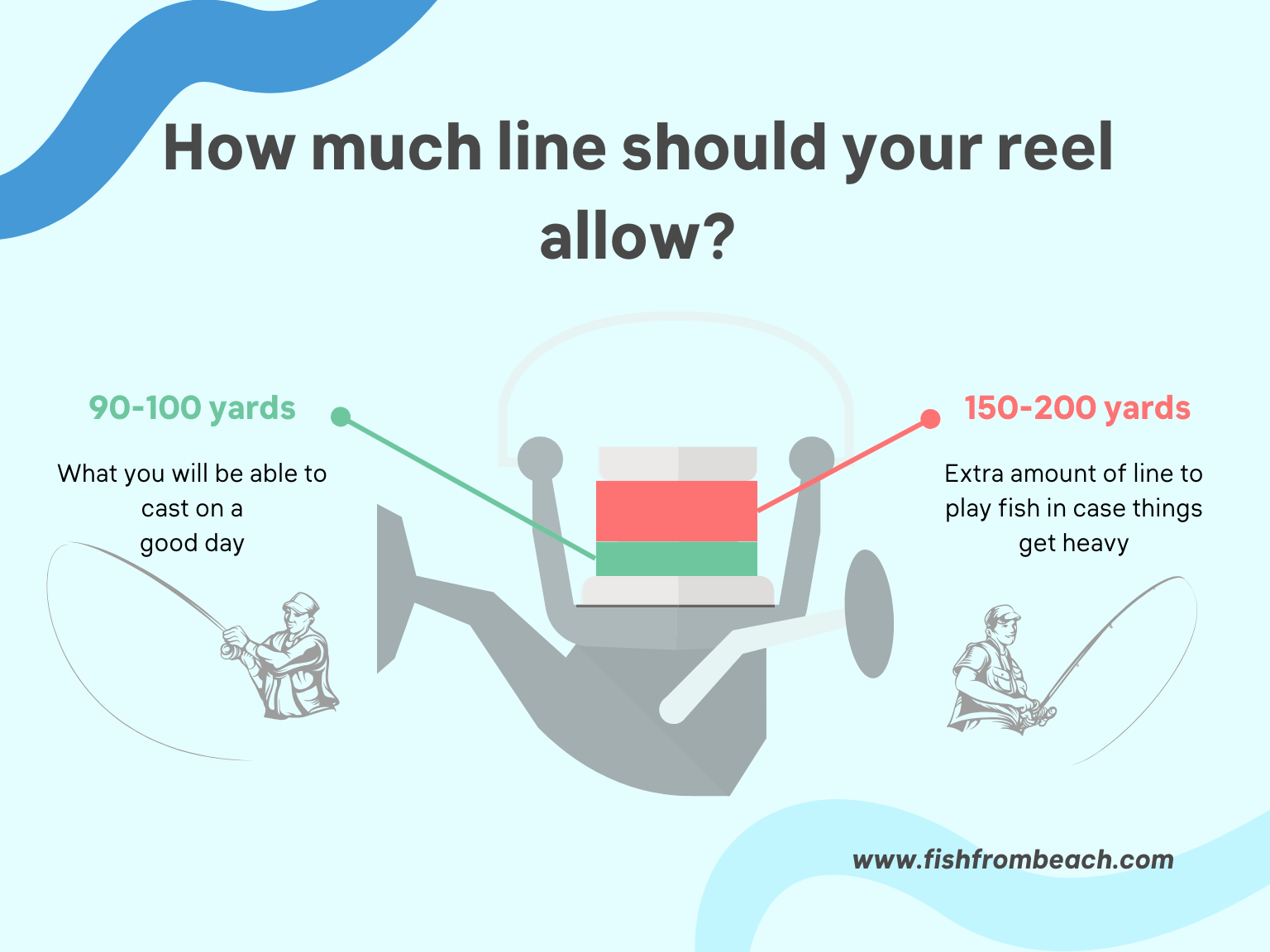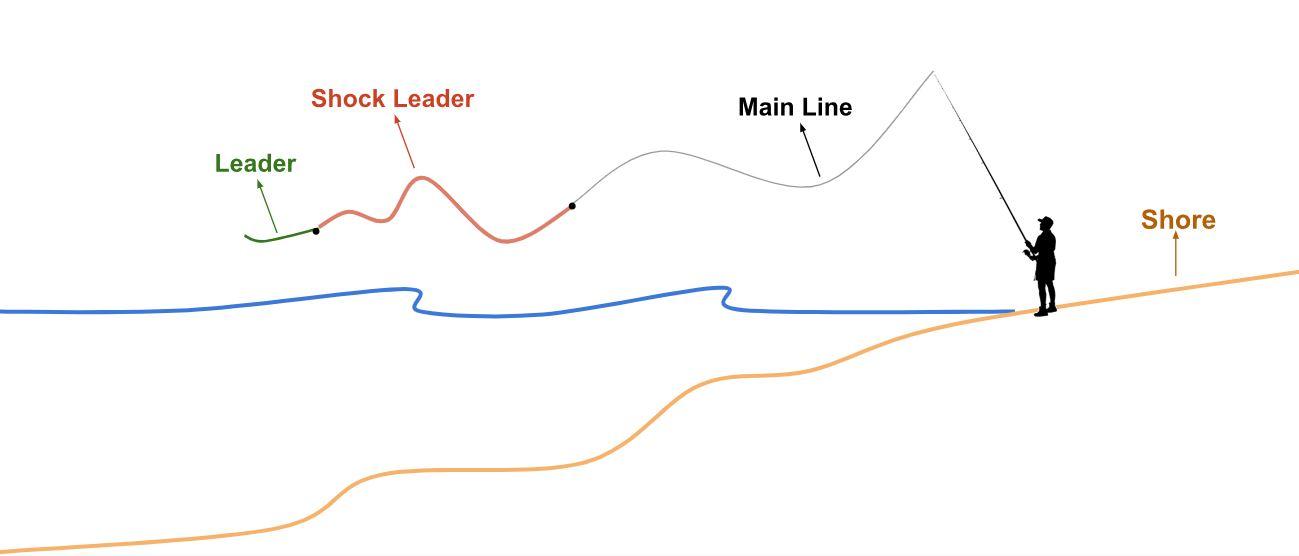The line is what connects you to the fish, it’s therefore crucial to choose the right one.
In this article, we will go through all the factors and resources to consider when choosing a line for surf fishing.
The goal is to fill up your reel with what can handle your targeted species while improving your overall productivity in the surf.
The takeaway
The best line for surf fishing is:
- 15-20 lb test monofilament or 30-40 lb test braid
- Monofilament for beginners and braid for advanced surf anglers
- Should not exceed 0.50 mm in diameter
- Plain clear color for minimum visibility. Camouflage should be the primary factor to consider when opting for other colors.

Which pound test for surf fishing?
The pound test (also called line weight) is the amount of weight your line can handle before it breaks. This means that the higher the pound test, the bigger the fish you can chase.
With this in mind, note that you can’t simply choose the highest pound test you find to target a wider pool of fish.
While high pound tests offer more strength and resilience, they also present a few drawbacks:
- The stronger the line the more prone it is to strong currents. This hurts your stability and prevents your bait from staying where you want it to be.
- A high pound test makes your line more visible in the water, which can spook fish and discourage them.
- A strong line receives more air resistance during casts which limits your casting reach.
- A high pound test also means a higher diameter, which limits the amount of line you can fit into the spool.
So you need to chase a sweet middle here. In other words, your pound test needs to be high enough to prevent frequent cut-offs and breaks, but not too high that it becomes counterproductive.
For surf fishing, 15-20 lb test monofilament or 30-40 lb test braid are the most common choices.
This pound test range allows you to target most species we catch in the surf and prove to offer good catch scores and productivity levels.
Read our complete guide about the best pound test for surf fishing.
Which line material for surf fishing?
When it comes to the line material, monofilament and braid are the two most common options.
Monofilament is more beginner-friendly because it is stretchy and offers more room for error. Monofilament is also a good abrasion-resistant and therefore works well when fishing rough grounds.
Braid, on the other hand, is ideal for agitated surf conditions and windy days as it is thinner and more sensitive. Braid is also the way to go when trying to maximize the casting distance because the low diameter cuts better in the air.
So it’s a tradeoff situation here. You need to consider your fishing conditions and goals before choosing your line material. For beginners, I usually recommend monofilament because it’s more forgiving and allows you to commit mistakes without facing severe consequences.
If you want to go deeper into this subject, I invite you to read this article where we compared the pros and cons of monofilament and braid.
How much line do you need?
A good target when casting into the surf is the edges of the first or second sandbar, right where the waves break. Such spots are usually located within the first 150 yards of the shore.
So typically, you should always have 250-300 yards of line in your reel. 150 yards will be dedicated to your casts (By the way, very few fishermen can reach that) and the other 100-150 yards will be dedicated to managing fights and catches, without the risk of being spooled out by a sizable fish.

There are two things worth noting here.
- Surf fishing reels usually range between size 4000 and 6000.
- The higher your line diameter, the less line you will be able to accommodate into the reel.
With these 2 points in mind, it’s therefore important to choose a diameter that is thin enough to allow you to have 250-300 yards of line on a typical surf reel.
Read more about the minimum amount of line required for beach fishing.
The optimal line diameter for surf fishing
Another reason why you need a thin diameter is because thick lines receive more pressure from the water, which can destabilize your terminal gear and make it more prone to drifting away from the desired spot.
A small-diameter line cuts better in the water and therefore helps keep your bait where it should be.
Thick lines also receive more friction from the air and wind during casts, which limits your reach and casting distance.
And as we said before, the bigger the diameter, the less line you will be able to fit into the spool.
So as a good rule of thumb, your line diameter should not exceed 0.50 mm when surf fishing. In terms of the pound test, that’s equal to around 20-25 lb when using monofilament, and approximately 80-100 lb when using braid.
The best line color for surf fishing
The line on your spool is very unlikely to be seen by fish because it’s not what will present your bait. You still need to attach a shock leader and final leader before attaching your hook. So don’t worry too much about the color of your main line.

Maybe the only thing to consider is to choose something that reflects sunlight effectively so you can easily spot your line when waiting for a bite or during a fight.
Orange, yellow, and red work great for this purpose.
Now, if your line risks being seen by fish and you want to be less visible, then opt for plain clear monofilament because that’s the least visible option.
If you want to use braid, then you need to choose a color that generates the weakest contrast underwater.
In other words, choose a color that blends with water. Clear, greenish, or bluish waters pair well with blue or green lines, while red, orange, bronze, or yellow lines suit shallow and muddy waters.
Worth noting here is that you need to exercise caution with red, as it turns black underwater, especially in deeper waters.
This creates high levels of contrast.
For deep surf fishing, remember that whatever color you choose, it will turn black or blue anyway. Here, light blue or green are the best choices because they ensure better camouflage.
Discover our guide to saltwater line color.
Note (*): If you make a purchase through links from this website, we may get a small share of the sale from Amazon or other similar affiliate programs.
Surf Fishing Survey
Help us provide you with better content by answering simple questions about your surf fishing experience and knowledge.
We will put the collected responses together and turn them into valuable information that will help you catch more fish from shore 😉
Note: No personal information will be collected with your answer.
